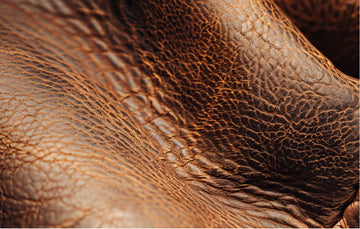How to Store and Protect Your Vintage Leather Bags: A Complete Guide
by VINTAGE LINEAGE on Feb 05, 2025

How to Store and Protect Your Vintage Leather Bags: A Complete Guide
Congratulations! You've mastered the art of cleaning and conditioning your vintage leather bags, ensuring they remain supple and radiant. But preserving these treasures doesn’t stop there—proper storage and protection are just as critical. This blog in the series focuses on how to store and protect your vintage leather bags to maintain their longevity and keep them looking timeless.
1. Why Proper Storage Matters
Leather is a natural material that breathes and reacts to its surroundings. Without proper storage, it can become:
- Dry or Brittle: Exposure to extreme temperatures or dry air.
- Moldy: Due to excessive humidity or poor ventilation.
- Misshapen: Improper storage methods can warp the leather’s shape.
To avoid these issues, follow the tips below to store your vintage leather bags safely.
2. The Perfect Storage Environment
Temperature and Humidity
- Ideal Temperature: Store leather bags in a cool and dark environment, ideally between 15°C and 25°C (59°F–77°F)
- Humidity Levels: Maintain humidity between 40% and 60% to prevent cracking (low humidity) or mold (high humidity).
- Avoid Extreme Conditions: Never store leather in attics, basements, or places exposed to direct sunlight or heat sources like radiators.
Ventilation
- Ensure the storage area is well-ventilated. Poor airflow can lead to musty odors and mold growth.
- Avoid airtight containers like plastic bins or vacuum-sealed bags, which can trap moisture.
3. Step-by-Step Guide to Storing Your Leather Bags
Step i: Clean and Condition Before Storage
Before storing, ensure your bag is clean and well-conditioned:
- Wipe off dust and dirt.
- Condition the leather to maintain moisture during storage.
- Let the bag dry completely before storing it to prevent mold or mildew.
Step ii: Use Dust Bags or Pillowcases
- Store your bag in a breathable cotton dust bag or a clean pillowcase to protect it from dust and scratches.
- Avoid plastic bags, as they trap moisture and can damage the leather over time.
Step iii: Stuff the Bag to Retain Shape
- Stuff the bag with acid-free tissue paper or a soft cotton cloth to help it maintain its shape.
- Avoid using newspapers, as the ink can transfer onto the leather.
Step iv: Store Upright or Lay Flat
- Store structured bags upright to maintain their silhouette.
- For unstructured bags, lay them flat to avoid unnecessary stress on the straps.
Step v: Keep Straps and Handles Untangled
- For bags with long straps, gently roll and tuck them inside the bag to prevent tangling or creasing.
Step vi: Use Leather-Safe Storage Boxes
- For long-term storage, use a breathable storage box lined with acid-free paper.(Avoid Newspapers)
- Avoid stacking bags, as this can lead to misshaping.
4. Protection Against Environmental Damage
Protect from Sunlight
- Direct sunlight causes fading and drying. Store your bag in a shaded area or use UV-protective covers if necessary.
Protect from Humidity
- Place silica gel packets or activated charcoal sachets inside the bag to absorb excess moisture.
- Avoid dehumidifiers that may over dry the leather.
Protect from Dust
- Dust particles can settle on the leather surface and degrade it over time. Wipe your bag with a dry cloth regularly, even in storage.
Protect from Insects and Mold
- Add natural repellents like cedar blocks or lavender sachets to your storage space.
- Check your bags periodically for any signs of mold or pests.
5. Traveling with Vintage Leather Bags
Preparation Before Travel
- Apply a light layer of leather conditioner to prepare your bag for varying climates.
- Pack the bag in its dust bag or use a protective cover.
During Travel
- Avoid placing your bag on wet or dirty surfaces.
- Keep it away from direct sunlight for extended periods.
Post-Travel Care
- Clean and condition your bag immediately after your trip to remove any dirt or stains it may have picked up.
6. Seasonal Care Tips
During Summer
- Protect from heat and sunlight. Store your bag in a cool, shaded area.
- Regularly check for signs of dryness and condition the leather more frequently.
During Monsoon or Humid Seasons
- Use moisture absorbers like silica gel or activated charcoal.
- Air out your bag periodically to prevent mold.
During Winter
- Avoid storing bags near heaters or fireplaces, as they can dry out the leather.
- Condition the leather to prevent it from becoming brittle.
7. Quick Fixes for Common Storage Issues
Creases or Wrinkles
- Fill the bag with tissue paper to reshape it.
- Use a leather-safe steamer or gently massage the area to smooth out wrinkles.
Musty Odours
- Place an open box of baking soda near the bag to absorb odours.
- Use a leather-safe deodourizer sparingly.
Stiffness or Dryness
- Apply a small amount of leather conditioner to rehydrate the leather.
- Avoid over-conditioning, as it can clog the leather pores.
8. Long-Term Maintenance Plan
- Inspect Periodically: Check your stored bags every 2–3 months for signs of mold, dryness, or other issues.
- Rotate Bags: If you own multiple leather bags, rotate them in and out of storage to avoid prolonged periods of inactivity.
- Re-Condition as Needed: Depending on your climate and usage, condition your bag every 3–6 months.
Conclusion: Invest in Protection for Timeless Elegance
Storing and protecting your vintage leather bags is a labor of love, but the reward is worth it. By following these steps, you can ensure your treasured bags remain in impeccable condition, ready to be admired and used for generations.

